A richly frescoed thermopolium, the Roman version of a street food stand, 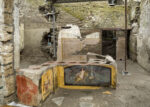 has been fully excavated and will open to the public starting Easter 2021. The cafeteria-style establishment is exceptionally intact, from frescoes painted on the front of an L-shaped counter to the earthenware pots still containing the remains of the snack bar’s last dishes. People ate out a lot in Pompeii. Eighty thermopolia have been found there, but this is the first one to be excavated in its entirety.
has been fully excavated and will open to the public starting Easter 2021. The cafeteria-style establishment is exceptionally intact, from frescoes painted on the front of an L-shaped counter to the earthenware pots still containing the remains of the snack bar’s last dishes. People ate out a lot in Pompeii. Eighty thermopolia have been found there, but this is the first one to be excavated in its entirety.
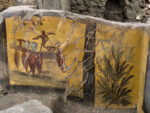 It was first discovered during stabilization work at the corner of the Alley of the Balconies and the Alley of the Silver Wedding in the Regio V neighborhood in 2019. The counter fresco of a nereid riding a sea horse was the first to emerge. A fresco on the shorter side of the counter depicted a counter with amphorae leaning against it and covered pots on top. Actual amphorae were discovered in front of the counter, mirroring the painted image which was likely a commercial sign of sorts.
It was first discovered during stabilization work at the corner of the Alley of the Balconies and the Alley of the Silver Wedding in the Regio V neighborhood in 2019. The counter fresco of a nereid riding a sea horse was the first to emerge. A fresco on the shorter side of the counter depicted a counter with amphorae leaning against it and covered pots on top. Actual amphorae were discovered in front of the counter, mirroring the painted image which was likely a commercial sign of sorts.
 The quality and preservation of the frescoed counter was so exceptional that archaeologists returned this year to excavate the site thoroughly and reveal the complete environment. This year’s phase of the dig unearthed another arm of the counter which was also adorned with frescoes. There were two panels framed in a black border: one wide one with two deceased ducks hanging upside down and a rooster against an architectural background, and the second with a black dog on a leash.
The quality and preservation of the frescoed counter was so exceptional that archaeologists returned this year to excavate the site thoroughly and reveal the complete environment. This year’s phase of the dig unearthed another arm of the counter which was also adorned with frescoes. There were two panels framed in a black border: one wide one with two deceased ducks hanging upside down and a rooster against an architectural background, and the second with a black dog on a leash.
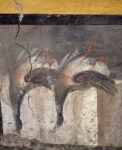 The ducks and chicken represent the wares offered at the cafeteria. The dog fresco has an obscene graffito inscribed into the black border. It reads “Nicia cineadecacator,” an insult to one Nicia (probably a freedman of Greek origin) calling him a shitter and an “invert”. Maybe Nicia was the owner of the establishment?
The ducks and chicken represent the wares offered at the cafeteria. The dog fresco has an obscene graffito inscribed into the black border. It reads “Nicia cineadecacator,” an insult to one Nicia (probably a freedman of Greek origin) calling him a shitter and an “invert”. Maybe Nicia was the owner of the establishment?
Bone fragments inside the vessels embedded into the countertops provide evidence of the bill of fare at the restaurant, including a mixed pork, goat, 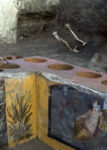 bird, fish and snail dish along the lines of a paella. A duck bone confirms that the mallard fresco was a menu item. One of the dolia contained wine residue and the remains of ground fava beans. The 1st century Roman cookbook Apicius’ De Re Coquinaria instructs that that bean meal and eggs whites should be added to “clarify muddy wine.” Long, vigorous stirring with a whip and an overnight soak apparently altered the taste and lightened the color of questionable vintages.
bird, fish and snail dish along the lines of a paella. A duck bone confirms that the mallard fresco was a menu item. One of the dolia contained wine residue and the remains of ground fava beans. The 1st century Roman cookbook Apicius’ De Re Coquinaria instructs that that bean meal and eggs whites should be added to “clarify muddy wine.” Long, vigorous stirring with a whip and an overnight soak apparently altered the taste and lightened the color of questionable vintages.
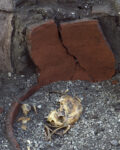 The skeletons of two individuals trapped and killed in the eruption of Mount Vesuvius, were discovered on the premises. The bones were jumbled, disturbed by looter tunnels dug in the 17th century. One set belonged to an adult about 50 years of age who was lying down on a bed or cot when the pyroclastic flow hit him. The nails and wood fragments from his bed were found under his remains. The bones of a second individual were found inside a large dolium (storage vessel) and may have been stashed there by the looters.
The skeletons of two individuals trapped and killed in the eruption of Mount Vesuvius, were discovered on the premises. The bones were jumbled, disturbed by looter tunnels dug in the 17th century. One set belonged to an adult about 50 years of age who was lying down on a bed or cot when the pyroclastic flow hit him. The nails and wood fragments from his bed were found under his remains. The bones of a second individual were found inside a large dolium (storage vessel) and may have been stashed there by the looters.
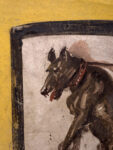 A complete dog skeleton was found in the northwestern corner of the room between two doors. It was the fierce lupine guardian in the fresco, but a tiny canine companion no more than 10 inches tall. This was an adult animal and is not of a known local breed. It was likely a imported toy breed.
A complete dog skeleton was found in the northwestern corner of the room between two doors. It was the fierce lupine guardian in the fresco, but a tiny canine companion no more than 10 inches tall. This was an adult animal and is not of a known local breed. It was likely a imported toy breed.
Inside the thermopolium were a total of nine amphorae, one bronze patera, two flasks and a tabletop ceramic olla (cooking pot). The floor of the space  was a layer of cocciopesto (waterproof flooring made of terracotta fragments) with embedded pieces of polychrome marble.
was a layer of cocciopesto (waterproof flooring made of terracotta fragments) with embedded pieces of polychrome marble.
The analysis of the remains — human, animal, culinary — is ongoing. A multi-disciplinary team of archaeozoologists, archaeobotanists, geologists and vulcanologists will study the material that has been recovered.